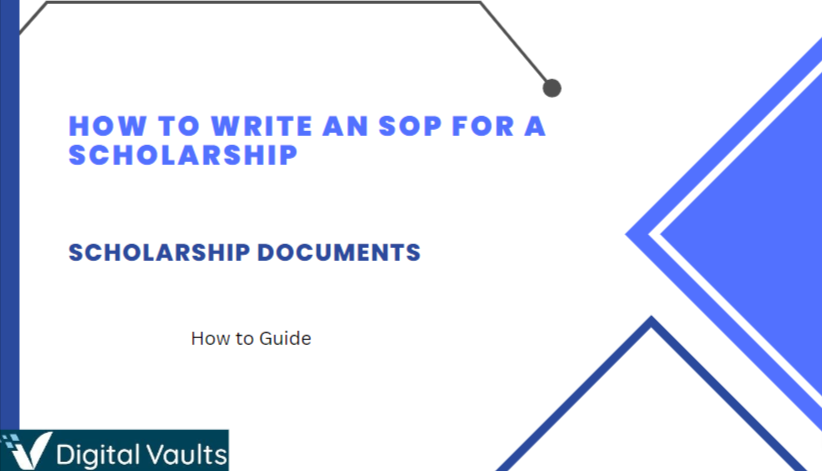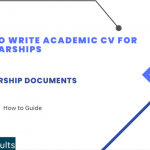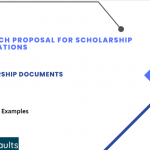How to Write an SOP for Scholarship – Statement of Purpose Guide Sample, Example, Tips and TricksJuly 2, 2024 by Digital Vaults Editorial Team
Have you ever wondered about how to write an SOP for a scholarship? An SOP, or statement of purpose, is an important part of your scholarship application. Fortunately, our friendly experts are here to ensure your scholarship application goes as smoothly as possible. And with this in mind, we’ve outlined a few key things you should know about how to write an SOP for a scholarship accordingly.

What is an SOP?
A statement of purpose, commonly shortened to SOP, is a specialist file designed to demonstrate your ability and motivation to apply for a scholarship. Indeed, scholarships are incredibly popular learning opportunities since they are fully funded. As a result, it’s important for scholarship providers to carefully consider the different applicants to find the individual who best meets the scholarship requirements.
Crucially, the SOP plays a vital role in this, as it allows a potentially successful candidate to show why they need the scholarship and how they’d be a good fit. The statement of purpose is designed to show your skills and suitability for the scholarship. As such, it first and foremost offers a brief review of your experience, skills, and achievements.
However, the statement of purpose (as the name would suggest) is also designed to highlight the writer’s intended purpose after the scholarship. In other words, the statement of purpose should indicate how you intend to use the knowledge and skills you develop during the scholarship to further your career goals or study ambitions.
To summarize,
- Convince the reader that you’re perfect for their program. Emphasize why their focus and goals match your interests.
- Showcase some solid skills and experiences that prove you’ve got the scientific and technical goods.
- Include concrete details about your accomplishments and qualifications. Quantitative stuff looks more impressive than just saying “I did great work.”
- Follow all their rules about length and formatting (usually around 2 pages max). Make sure to color inside the lines on their requirements.
Keep it brief but persuasive. Prove you’ve got the skills and fire to shine in their program.
Your statement of purpose is where you can really connect with the admissions folks. This is your chance to toot your own horn and show why you’d rock their program.
Don’t lie, but don’t be modest either – brag about your cool experiences and what makes you an awesome candidate. Confidence is key here.
Keep it real, but highlight all your great qualities and skills. Make them want you in their class. Don’t leave them any doubt that you’d kill it if you got in.
Rock that SOP! It’s your opportunity to charm the socks off the review committee. Seize the moment to sell, sell, sell yourself.
Tailor Your SOP to the Nature of the Scholarship
It’s also important to clarify that the main point of focus for each statement of purpose will highly depend on the nature of the scholarship. For example, if you are applying for a sports scholarship, your statement of purpose will have very different themes and focal points than an academic study scholarship SOP, and so on.
Make sure to consider why you are being offered the scholarship and highlight this in your statement of purpose. This will help demonstrate to the assessor why you deserve the chance to win the scholarship rather than completing the study course as a paying student.
Join our Telegram Channel to Get the Latest International Scholarship Alerts and Tips.
How Do I Use an SOP for a Scholarship?
While every scholarship application process is different, for the most part, you will only have to write your statement of purpose after the initial shortlisting process. As such, if you’re invited to write an SOP by the scholarship provider, you’ve got a good chance of winning the scholarship. Still, your SOP can make or break your application, so there’s no room for error.
Generally speaking, you use the SOP for three main purposes. These are as follows:
- Your SOP should clarify why you are a good applicant for the scholarship
- The SOP needs to cover how the scholarship’s terms meet your situation
- A good SOP should outline how the scholarship will help your future endeavors
If your statement of purpose successfully covers all three of these points, you should be confident that you have a good chance. Remember, though: everything’s still to play for when it comes to winning the scholarship. It’s a good idea to start your SOP in advance or summarize the key points you’d like to make.
How to Write an SOP for a Scholarship
Now that we’ve clarified what a statement of purpose is and how it works, it’s important to look at how to write an SOP. Fortunately, these files are relatively easy to create. You’ll need to dedicate enough time to your SOP to ensure it’s written effectively. This single file can potentially make or break your scholarship application.
Summarize the Key Points
Before you begin writing your SOP, it’s helpful to summarize the three key points we mentioned before. This can be done well before receiving an SOP offer, as it will take a little time. However, brainstorming this at the beginning of the process can give you a direction to work toward your SOP. Doing so helps ensure your SOP is consistent with everything you mentioned in your CV and resume.
Consider How Your Points Relate to the Scholarship Type
There are countless scholarships available, and your SOP needs to align with this. As such, a generic SOP won’t cut it. Your statement of purpose needs to demonstrate your suitability for the exact terms of the scholarship.
Some of the most common scholarship types include the following:
- Academic scholarships
- Athletic scholarships
- Need-based scholarships
- Background (gender, culture, social)
Depending on the type of scholarship you are applying for, you can tailor your SOP to address how you meet the criteria. For example, with academic scholarships, you can focus on your previous academic achievements and how these relate to the scholarship in question. Meanwhile, highlight your dedication, experience, and passion for a need-based scholarship and cover why you need scholarship support to achieve your goals.
Keep this in mind throughout the process of writing your statement of purpose. This will make it easier for you to accurately tailor the SOP to the scholarship’s requirements, demonstrating more clearly than a resume or CV how you are a good fit for the target demographic.
Open By Addressing the Need for a Scholarship
The first thing your SOP needs to do is hook the reader’s attention. With this in mind, you need to open the document by highlighting why you need a scholarship and how this could help your own goals and achievements in life.
One of the best ways to achieve this is to start with a story from your life highlighting some struggle that relates you to the scholarship. Not only is this an emotive way to get the assessor’s sympathy and help them relate to your SOP, but it also proves your dedication. After all, a scholarship should never be something you go for on a whim. Assessors will be looking for someone who can be passionate about the topic. The opening of your SOP is the ideal place to highlight this to create a powerful first impression.
Ideally, the story should be something that’s recent enough to be intellectual. Cliché stories of “From an early age, I’ve always wanted…” are unlikely to gain much merit. However, they should show some form of realization of your need for a scholarship or your dreams in life – which the scholarship can help you achieve. The exact nature of this will vary depending on your background and the like.
What could be a good option here? Well, try to focus on the type of scholarship you are applying for. If you’re applying for a needs-based scholarship, for example, you could try to think of the time you realized that a scholarship could help you achieve your dreams.
It doesn’t have to be a long story here. A few lines may be enough – but make sure it’s a powerful enough story to hook the reader’s attention and show why you fit the criteria perfectly.
Highlight Your Academic Interests
Once you’ve written your SOP introduction, you can then look at progressing through the document. There’s no set way to do this, but following up with your current academic achievements can help. This immediately shows how hard you have already worked to achieve your current grades and demonstrates to the assessor that you are dedicated, determined, and hardworking.
For any subjects or academic achievements relating directly to your course, try to go more in-depth about what you enjoyed, what you wanted to learn more about and the like. If you can tie this into the focus of your scholarship, you’ll provide the assessor with a clear background of your interest. This link helps add credibility to your application and shows you have a genuine, vested interest in the topic already.
Clarify Your Previous Experience
Not everything can be learned in a classroom. So, highlighting any previous experience can go a long way toward bolstering your application. Remember to mention what you learned during each experience and how this relates to your chosen scholarship.
In addition, highlight ways you furthered your knowledge after the work experience. This step will show how much of an impact this had on your passions and interests.
If you don’t have professional work experience, there are still plenty of ways you can relate your current achievements and interests in this section. You can also discuss any experience with personal projects or classroom-based experiments here. However, it would be best to try to ensure you have at least one form of relevant work experience before applying for the scholarship. Even if it’s only indirectly related, any work experience that helps you develop valuable skills is better than none.
Extra-Curricular Activities
Scholarships often look very favorably on extra-curricular activities. This point is especially common when it comes to academic and athletic scholarships, as extra-curricular activities can often relate to your area of study or future pursuits. As such, be sure to include any relevant activities that you have previously engaged in. Be sure to highlight how this has helped grow your skills.
Some common examples of extra-curricular activities that will often be valuable for scholarship applications include:
- Competitions
- Leadership roles
- Projects
- Events
Explaining Your Choice
A further section that you should include in your SOP writeup relates to your choice of course and university – in other words, why does this particular course work for you? How will this course help further your ambitions and goals, and why is this scholarship such a valuable option to consider for your circumstances?
In addition, try to explain what you can bring to the community in this section. Many scholarship providers actively want to see their scholarship students engaging with the wider community, which can significantly support diversity and inclusivity. With this thought in mind, demonstrating how you can help the community will go a long way toward strengthening your case.
Sample
A good SOP should always end with a brief conclusion. In around three lines or sentences, try to summarize the main reasons why you are a good choice for the scholarship, what you can bring, and what you hope to achieve with the knowledge the scholarship helps support.
Crucially, your conclusion should also thank the reader for taking the time to go through the statement of purpose. Even though it’s likely their paid job role to do so, a little courtesy can work wonders to brighten the assessor’s mood (and potentially improve their perception of you further).
https://graphics.stanford.edu/~zhossain/grad/sop_mit.pdf
Tips When Writing a Standard Operating Procedure for a Scholarship
While writing your SOP, keeping a few important tips in mind is important. Several main things you should consider to increase the chances of your SOP being written effectively include the following points.
Always Write in Clear Paragraphs
Your statement of purpose offers a great opportunity to demonstrate your writing skills. After all, in many cases, scholarships are based on examinations, essays, and assignments – and being able to write effectively and clearly will help a lot here.
As such, you should always write in clearly defined paragraphs for your SOP to show your ability to format essays. This can go a surprisingly long way toward supporting your application. Similarly, a poorly-formatted SOP is much more likely to get rejected.
Never Plagiarize Content
When writing your SOP, taking inspiration or directly copying other successful or effective SOPs online can be tempting. However, the assessor may check your submission for plagiarism, and any copied content will severely harm your application’s standing. A plagiarized assessment is unlikely to pass, so you may lose your chance of achieving a scholarship by copying content closely.
Don’t Make it Overly Long.
Don’t forget that the assessor will have already seen most of the information in your CV and resume by the time you are offered to write an SOP. As such, treat your SOP as a summary of the previous documents primarily and only include the most important information (i.e., your main achievements). A target length of around 800 to 1000 words is usually suitable.
Never Lie in your SOP
Many people start an SOP with a story to hook the reader’s interest – but don’t fall into the trap of lying or exaggerating the story. Not only are lies often easy to recognize, but if you get asked about this, you might end up stumbling to remember what you said later. This often means that any untruths get exposed down the line, which can jeopardize your application.
Be Unique!
We’ve presented some key things you should include in your SOP today. However, it would be best if you also strived to be unique in your statement of purpose. So, go for it if you’d like to add something else or change the structure slightly if it suits your experience better. Ensure the final SOP is clear, flows well, and has easy, obvious transitions between each section.
Join our Telegram Channel to Get the Latest International Scholarship Alerts and Tips.
Final Thoughts
If you plan to apply for a scholarship, it’s important to begin thinking about how you will write your SOP as soon as possible. Of course, it’s worth keeping in mind that an SOP isn’t a basic part of your scholarship application; if you are given a chance to write an SOP, that’s great news! However, the hard work isn’t over yet, and you’ll need to put 110% into writing your SOP to demonstrate that you’re the right applicant for the scholarship.
Please don’t leave it to chance; find the ideal opportunities for your own SOP writing goal.


